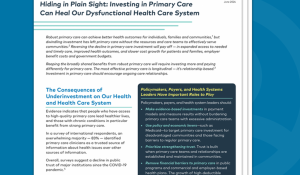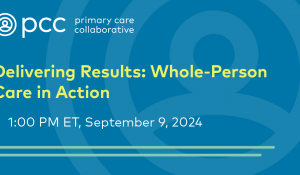You are looking at an archived version of our site. Please visit thepcc.org for a fresh, new experience!
Primary Care Investment
Greater investment in primary care is associated with lower costs, higher patient satisfaction, fewer hospitalizations and emergency department visits, and lower mortality. Despite current high levels of healthcare spending in the United States, the proportion spent on primary care is insufficient. A shift in resources to support greater access to comprehensive, coordinated primary care is imperative to achieving a stronger, higher-performing healthcare system.
Underinvestment in primary care gives rise to patient access and workforce issues. A significant financial incentive for physicians and other clinicians to choose other areas of specialty undermines primary care.

News
Febbraio 6, 2020 | Patient Engagement HIT
Febbraio 6, 2020 | The Milbank Memorial Fund
Gennaio 27, 2020 | American Medical Association
- ‹ precedente
- 8 di 23
- seguente ›
Events & Media
There are currently no upcoming events.
- ‹ precedente
- 7 di 7
Related Content
| Titolo | Sorgente | Data |
|---|---|---|
| Primary Care as Healthcare Infrastructure | Harvard Health Policy Review | Ottobre 5, 2018 |
| JAMA Forum: Progress in Primary Care—From Alma-Ata to Astana | JAMA | Ottobre 3, 2018 |
| Making New York City a primary care town | City & State New York | Ottobre 2, 2018 |
| Employers jump into providing care as health costs rise | Associated Press | Settembre 30, 2018 |
| Amazon, Berkshire Hathaway and JPMorgan Name C.E.O. for Health Initiative | New York Times | Giugno 20, 2018 |
| A Health Plan ‘Down Payment’ Is One Way States Try Retooling Individual Mandate | Kaiser Health News | Marzo 9, 2018 |
| 9 major takeaways from the 2018 MACRA proposed rule | Healthcare Dive | Giugno 26, 2017 |
| 13 less-noticed CBO findings on the ACA repeal bill | Modern Healthcare | Marzo 14, 2017 |
| Advocates Of Flat-Fee Primary Care See Opening In GOP’s Market-Driven Approach | Kaiser Health News | Febbraio 28, 2017 |
| A Consumer’s Guide To Medicare’s New Rules On Doctor Pay | Kaiser Health News | Novembre 17, 2016 |
Pagine
Menu secondario
Copyright © 2024 Primary Care Collaborative






